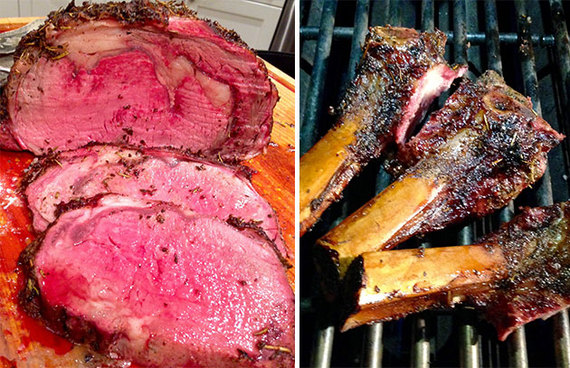
In 2013 I wrote, "Spit-roasting is my hands-down favorite method for cooking prime rib. Thanks to the slow, gentle rotation, the meat cooks evenly and bastes in its own melting fat."
Today, I'd like to reverse myself--reverse being the key word. This year I'm using the "reverse sear" method.
Reverse-searing has flooded the blogosphere recently. So you might be surprised to learn that it's been around since 2001 when one Christopher Finney, member of the competition cooking team Iron Pig BBQ, claims to have invented reverse searing.
In a nutshell, you smoke or indirect grill thick cuts of beef and other meats to within a few degrees of your ultimate desired internal temperature, rest them, then sear at high heat. The result is meat that is uniformly pink across its diameter--cooked to temperature--with a beautifully crusted exterior. (Traditionally, meat is seared, then roasted, a technique that yields a "bulls-eye" effect, where a blood-red center is surrounded by concentric rings of pink, then grey, then brown meat.) This method works for all sizes of prime rib, from a modest 2-bone piece that will feed four, to a massive 7-bone piece that will feed up to 20.
Here are some simple tips for prime rib success:
- Generously--and I mean generously--season the meat with coarse salt (kosher or sea) and freshly ground black pepper on all sides at least an hour before cooking or even the night before. I personally like to rub the roast first with extra virgin olive oil, minced garlic, and chopped fresh rosemary. Let the meat rest, uncovered in the refrigerator, on a wire rack set over a rimmed baking sheet.
- Roast the meat until the internal temperature is 5 to 10 degrees below your desired finished temperature. For me, that's 120 degrees. (Temperatures in well-marbled meats should be high enough to melt the intramuscular fat.) This could take up to 4 hours.
- Remove the meat from the grill or smoker, loosely tent with foil, and let rest for 15 minutes before searing the outside of the prime rib directly on the grill grate over high heat.
Get more prime rib tips and instructions at BarbecueBible.com.
SIGN UP for Steven Raichlen's UP IN SMOKE newsletter to learn more about barbecue!
READ MORE ABOUT GRILLING AT BARBECUEBIBLE.COM
--
Steven Raichlen is the author of the Barbecue! Bible cookbook series and the host of Project Smoke on public television. His web site is BarbecueBible.com.
-- This feed and its contents are the property of The Huffington Post, and use is subject to our terms. It may be used for personal consumption, but may not be distributed on a website.
No comments:
Post a Comment